As you can imagine from my latest posts (on kurgan origins and on Sredni Stog), I am right now in the middle of a revision of the Corded Ware culture for my Indo-European demic diffusion model, to see if I can add something new to the draft. And, as you can see, even with ancient DNA on the table, the precise origin of the Corded Ware migrants – in spite of the imaginative efforts of the Copenhagen group to control the narrative – are still unknown.
Corded Ware origins
The main objects of study in Corded Ware origins are necessarily the region where the oldest Corded Ware vessels appeared, Lesser Poland, as well as the adjacent (traditionally considered Proto-Corded Ware regions) Volhynia, Podolia, and upper Dniester river basin. These are some relevant points, continuing where I left the Eneolithic steppe developments (following Szmyt 1999, Rassamakin 1999, Kadrow 2008, Furholt 2014):
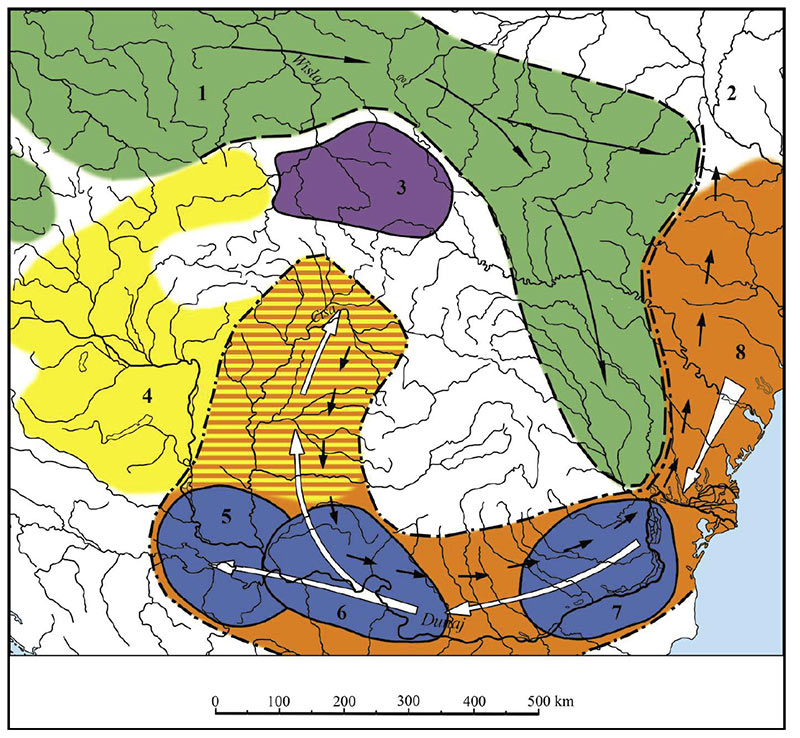
- More frequent contacts were seen ca. 3500-3000 BC, with an interaction showing multidirectional migrations of larger human groups in the centuries around 3000 BC, involving a significant part of the population of central-east Europe.
- The easternmost area of the Funnel Beaker culture had become more Baden-like with the expansion of the Baden culture in its western area ca. 3300-2900 BC (with findings up to 2600 BC), and these younger groups with Baden features moved increasingly into the western part of Volhynia.
- The influence of the neighbouring Trypillian culture is seen in the eastern parts of Volhynia, from ca. 3000 BC, either from a younger phase CII (cf. Troyaniv, Koshilivtsy, Brînzeni, Zhvaniets, or Vychvatintsy) or later groups (cf. Gorodsk, Kasperivtsy, Sofievka, Horodiştea-Folteşti, Usatovo).
- In the forest-steppe zone, herding and hunting activities intensified, while agricultural traditions were preserved, as shown by the Sofievka, Kasperivtsy, and Gorodsk groups. From the end of the 4th millennium BC mobile parts of the late Trypillian populations moved to the steppe zone, absorbing more and more steppe elements; among others, cord ornamentation (in Vykhvatintsy, Troyaniv, and Gorodsk groups), pottery forms (Vykhvatintsy, which served as prototype for the Thuringian Apmphorae, dispersed along the Dniester river, too), flat burials with bodies in contracted position on the left or right side (Vykhvatintsy, reminding of Polgár culture different male-female position, and later Corded Ware burials, and also Lower Mikhailovka, under a mound without stone constructions). At the end of the Trypillia culture, its agricultural system collapsed completely.
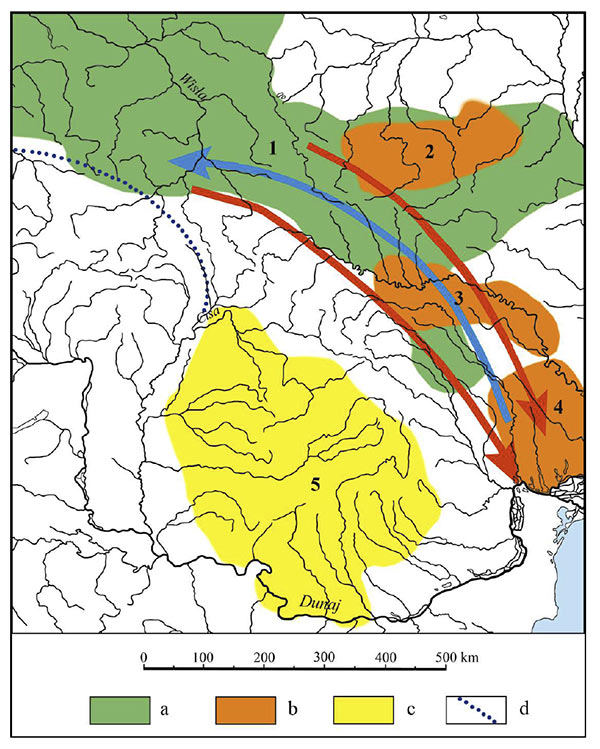
- Slash and burn techniques of agriculture – especially those practiced by Trypillian and Funnel Beaker populations – must have intensified effects of natural growth of humidity (ca. 3400-2400), increasing fluvial activities in west Ukrainian river valleys, and increasing deforestation processes, which favoured pastoralism and nomadisation of the settlement system, and a consequent change of the social structure
- At the same time, Yamna communities expanded along the lower and central Danube to the west, while the populations of the late phase of the Baden culture took the opposite direction and reached as far as Kiev in the north-east, contributing to the culture of the Sofievka group.
- Globular Amphora communities migrated from the north-west, from eastern Poland, towards the Danube Delta and as far as the Dnieper in the east, destroying the primary structures of the communities in the supposed cradle territories of the Corded Ware culture. These communities found refuge and conditions for further development in south-eastern margin zone of the Funnel Beaker culture territories, penetrating at first the upper parts of the loess uplands like typical Funnel Beaker sites, but on the margins of their range, and also on areas avoided by Funnel Beaker settlement agglomerations. They brought with them the so-called Thuringian amphora up to Lesser Poland, borrowed from the late Trypillian Usatovo group. This resulted in the Złota culture, which eventually gave rise to the A-Amphorae.
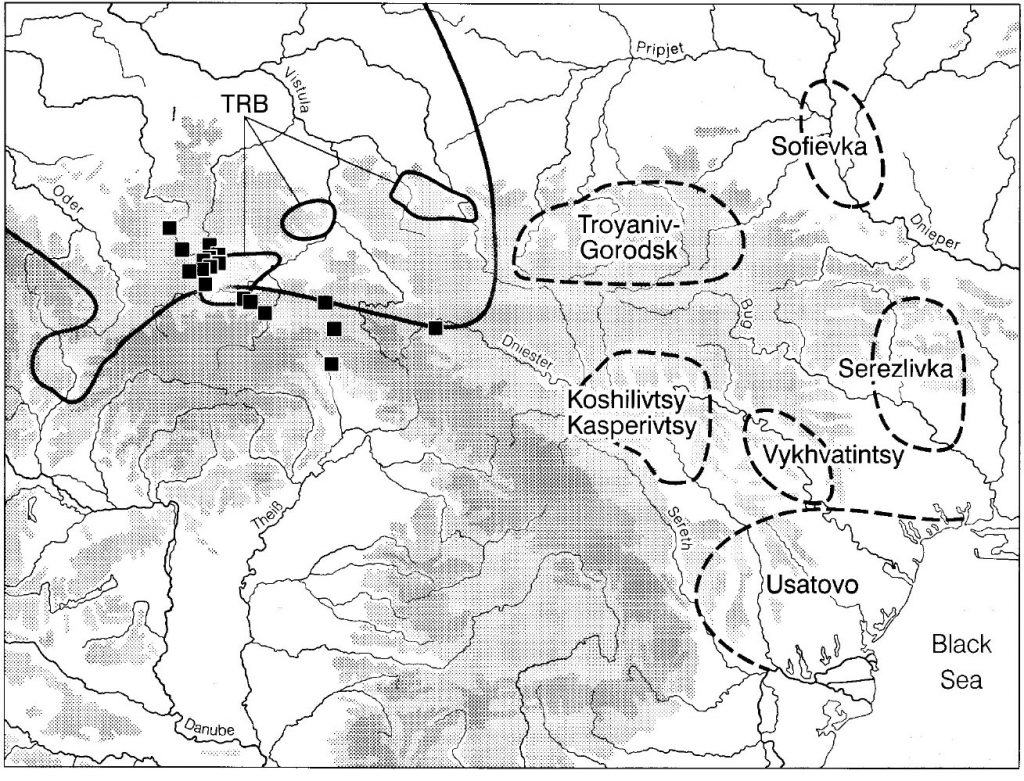
In the end, we are left with this information about the oldest CWC (Furholt 2014):
- The earliest radiocarbon-dated groups associated with the Corded Ware culture come from new single graves from Jutland in Denmark and Northern Germany, ca. 2900 BC. This Early Single Grave culture is associated with the appearance of individual graves (some time after the decline of the megalithic constructions), composed of a small round barrow and a new gender-differentiated burial practice emphasising male individuals orientated west-east (with regional exceptions), combined with the internment with new local battle-axe types (A-Axe). However, there is no single type of burial or burial custom in Corded Ware:
- In southern Sweden the prevailing orientation is north-east – south-west, and south-north, contrary to the supposed rule male individuals are regularly deposited on their left and females on their right side.
- In the Danish Isles and north-eastern Germany, the Final Neolithic / Single Grave Period is characterized by a majority of megalithic graves, with only some single graves from typical barrows. In south Germany, west-east and collective burials prevail, while in Switzerland no graves are found.
- In Kujawia (south-eastern Poland), Hesse (Germany), or the Baltic, west-east orientation and gender differentiation cannot be proven statistically.
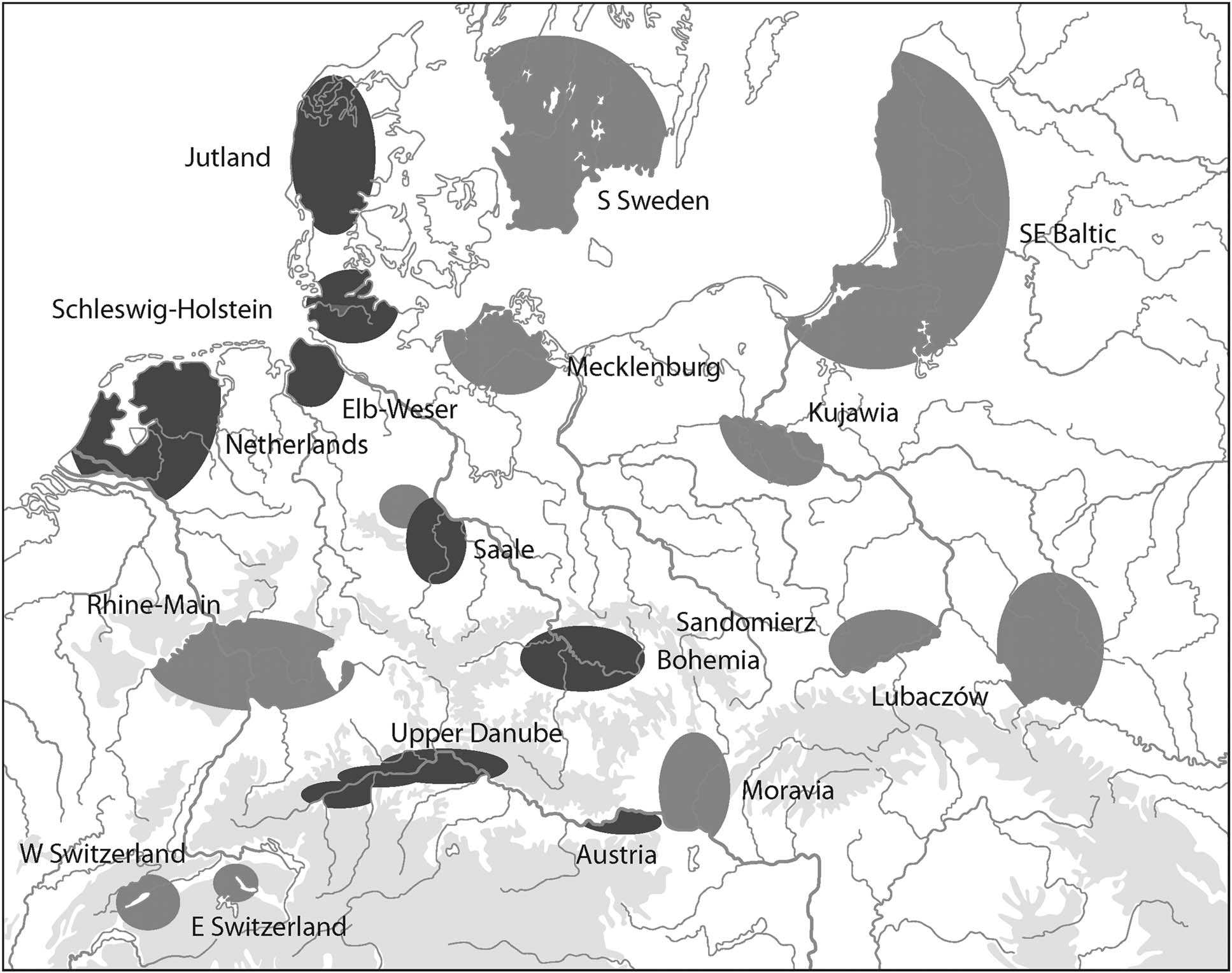
- The oldest Corded Ware vessels (the A-Amphorae, which define the A-Horizon of the CWC) come probably from the Złota (or a related) group in Lesser Poland, where a mixed archaeological culture connecting Funnel Beaker, Baden, Globular Amphorae and Corded Ware appears ca. 2900-2600 BC. No cultural (typological) break is seen between earlier Globular Amphorae and the first Corded Ware Amphorae, but rather a continuum of traits and characteristics among the recovered vessels. This strengthens the connection of Corded Ware with Globular Amphorae peoples. The A-horizon expanded thus probably from Lesser Poland ca. 2800-2600, as seen in local contexts.
- And of course we have a third way of defining Corded Ware individuals, which is the presence of herding, and thus a transition from hunter-gatherers to agropastoralists. This is how some Baltic Late Neolithic individuals with no archaeological data have been classified as members of the Corded Ware culture: Even though no cultural remains were extracted with the two ‘outlier’ individuals, their haplogroup and ancestry point to a direct origin in or around the steppe and forest-steppe region (yes, that risks circular reasoning).
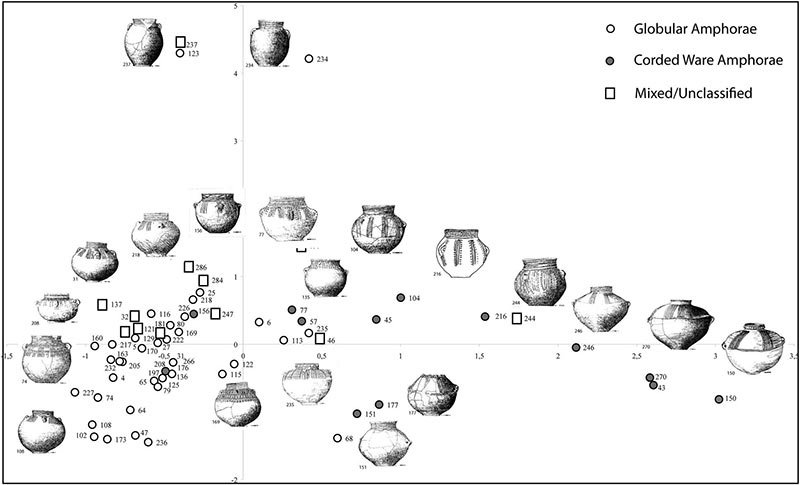
Corded Ware peoples in genetics
So, no clear origin of Corded Ware migrants, a lot of data pointing to intense migrations and interaction among GAC, Trypillia and the western steppe population (remember Kristiansen’s ‘long-lasting GAC-CWC connection’, now ignored to favour their Yamnaya admixture™ concept), and also three ways of defining Corded Ware culture…
Maybe genetics can help:
Ukraine Neolithic cultures – mainly from Dereivka – show haplogroups R1b-V88, R1a1, and R1b-L754 (xP297, xM269), which is similar to the haplogroup distribution found in Ukraine Mesolithic, but apparently with an expanding group marked by haplogroup I2a2a1b1 (possibly I2a2a1b1b).
The first thing that stands out about Ukraine Eneolithic samples is that only two of them can be said to be really Ukraine Eneolithic (i.e. from “Sredni Stog”-related groups):
- I5876 (Y-DNA R1a-Z93(Y3+), mtDNA U5a2a), from Alexandria, 4045-3974 calBCE (5215±20BP, PSUAMS-2832)
- I4110 (mtDN AJ2b1), from Dereivka, 3634-3377 calBCE (4725±25 BP, UCIAMS-186349), J2b1
The other two samples are quite late, and in fact one of them is clearly too late (maybe from the Catacomb culture):
- I5882 (mtDNA U5a2a), from Dereivka, 3264-2929 calBCE (4420±20BP, PSUAMS-2826)
- I3499 (Y-DNA R1b-Z2103, mtDNA T2e), from Dereivka, 2890-2696 calBCE (4195±20BP, PSUAMS-2828)
Corded Ware samples from Mittnik et al. (2018) offer very wide radiocarbon dates, so it is unclear which of them may be the oldest one. Most of them cluster closely to the older Ukraine Eneolithic sample I5876, but also to later steppe_MLBA samples i.e. Sintashta, Potapovka, and especially Srubna and Andronovo). This points to a genetic continuity from Pre-Corded Ware to Classic and late Corded Ware peoples. Therefore, much like Khvalynsk-Yamna and apparently many other Neolithic cultures, these peoples did not really admix; at least not with the male population.
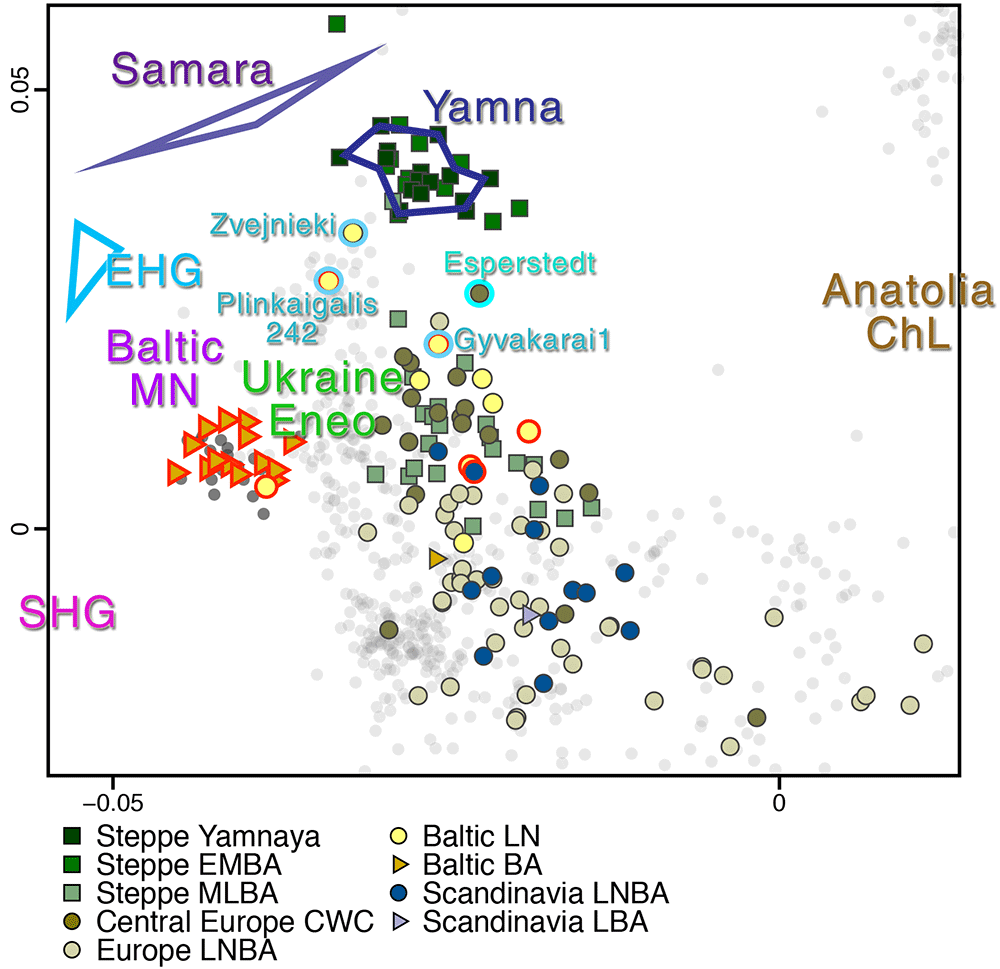
Lucky for us, even though the culture remains undefined, haplogroup R1a-Z645 seems like a unifying trait, as I said long ago, so we only have to wait for more samples to trace their origin. Nevertheless, it is clear that Corded Ware may not have been as genetically homogeneous as Khvalynsk, Yamna and Yamna-related cultures, further supporting its archaeological complexity:
- Jagodno1 and Jagodno2 (Silesia), dated ca. 2800 BC, show haplogroup G? and I/J? – compatible with an origin of CWC in common with Trypillia (which shows 3 samples of haplogroup G2a2b2a, and one E) and Ukraine Neolithic (showing the expansion of I2a2a1b1 subclades).
- I7272, from Brandýsek (Czech Republic), dated ca. 2900-2200 BC shows haplogroup I2a2a2 (
compatible with an origin in Ukraine Neolithic peoples – this haplogroup is also found in Yamna Kalmykia and in the Yamna Bulgaria outlier, i.e. late western samples from the Early Yamna culture).
NOTE. This precise subclade is only present to date in Chalcolithic samples from Iberia, which points (possibly like the Esperstedt family) to local Central European haplogroups integrated in a mixed Proto-Corded Ware population. The upper subclade I2a2a is found in Neolithic samples from Iberia, the British Isles, Hungary (Koros EN, ALPc), and also south-east European Mesolithic and Neolithic samples.
- RISE1, from Oblaczkowo (Greater Poland), ca. 2865-2578 BC, shows haplogroup R1b1.
- The Esperstedt family samples have been analysed as R1a-M417 (xZ645), although the supposed ‘xZ645’ has not been confirmed – not even in the risky new Y-calls from Wang et al. (2018) supplementary materials.
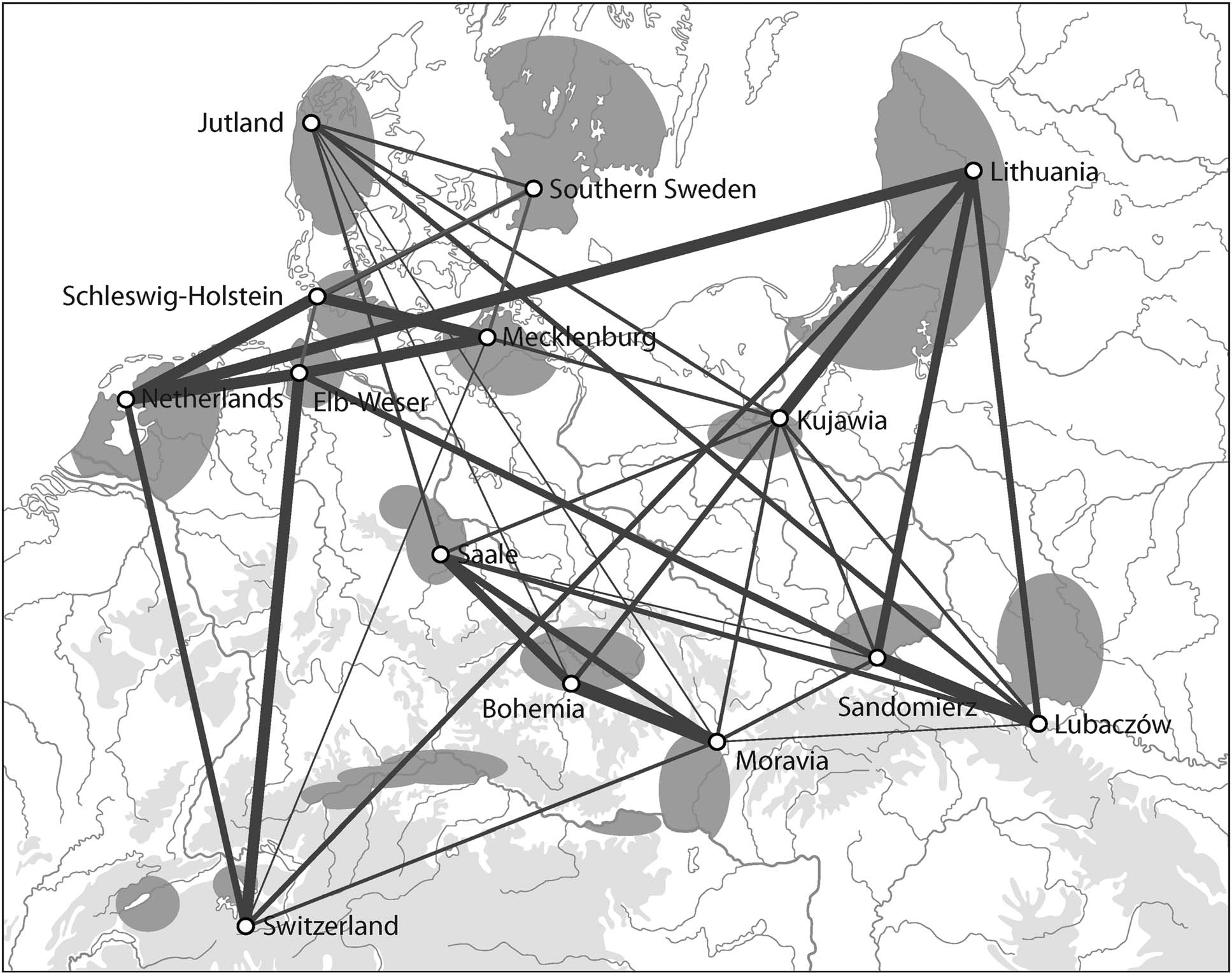
weapons and ornaments as stated in Table 1, based on the catalogues given in Table 2, line thickness representing similarity
Maybe this heterogeneity is a problem of better defining the culture, but from what we can see the oldest CWC regions and the unifying ‘Corded Ware province’ – formed after ca. 2700 BC by Jutland and Northern Germany, the Netherlands, Saale, Bohemia, Austria and the Upper Danube regions – are for the moment not the most genetically homogeneous groups.
Homogeneity comes later – which we may tentatively identify with the expansion of the A-horizon from the northern Dnieper-Dniester and Lesser Poland area – , as seen around the Baltic (like the Battle Axe culture) with R1a-Z283 subclades, and around Sintashta (i.e. probably Abashevo – Balanovo) with R1a-Z93 subclades, which is compatible with the late spread of different Z645 groups (and potentially a unifying language) .
Related
- Sredni Stog, Proto-Corded Ware, and their “steppe admixture”
- Kurgan origins and expansion with Khvalynsk-Novodanilovka chieftains
- About Scepters, Horses, and War: on Khvalynsk migrants in the Caucasus and the Danube
- Steppe and Caucasus Eneolithic: the new keystones of the EHG-CHG-ANE ancestry in steppe groups
- The Caucasus a genetic and cultural barrier; Yamna dominated by R1b-M269; Yamna settlers in Hungary cluster with Yamna
- The concept of “Outlier” in Human Ancestry (III): Late Neolithic samples from the Baltic region and origins of the Corded Ware culture
- Consequences of Damgaard et al. 2018 (II): The late Khvalynsk migration waves with R1b-L23 lineages
- On the potential origin of Caucasus hunter-gatherer ancestry in Eneolithic steppe cultures
- Eneolithic Ukraine cultures of the North Pontic steppe and southern steppe-forest, on the Left Bank of the Dnieper
- North Pontic steppe Eneolithic cultures, and an alternative Indo-Slavonic model
- New Ukraine Eneolithic sample from late Sredni Stog, near homeland of the Corded Ware culture
- The renewed ‘Kurgan model’ of Kristian Kristiansen and the Danish school: “The Indo-European Corded Ware Theory”